Your equatorial mount is the #1 most important item for astrophotography of deep-sky objects. The mount should always be the most expensive part of your setup. If you can afford nothing but a mount, just get an adapter and put your DSLR or lens on if you can, then upgrade to a scope later. The mount rules all.
Almost all the best astrophotography mounts sold today, apart from a few premium offerings outside the scope of this article, are computerized German equatorial mounts. These astrophotography mounts are the most lightweight, versatile, and inexpensive options available to amateurs.
Best EQ Mounts For Astrophotography Reviewed
1. Sky-Watcher EQM-35 – Cheapest Choice (Under $1000)
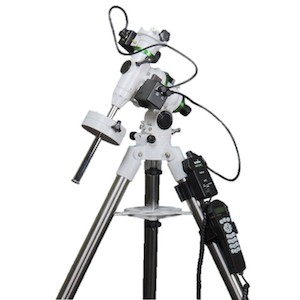
- Inexpensive
- Same basic features of bigger mounts e.g. autoguiding
- Lightweight
The EQM-35’s lightweight and low cost make it great for beginning astrophotographers. And just like more expensive equatorial mounts, the EQM-35 is fully compatible with autoguiders, PC control software, and anything else you need for imaging.
Sky-Watcher mysteriously claims a 22-pound weight capacity for the EQM-35, yet also doesn’t recommend shoving anything remotely near that heavy onto it. I put a Celestron C8 (about 14 pounds) on the EQM-35 and it was not the steadiest for visual astronomy. So I’d wager that in practice, the EQM-35’s weight capacity is closer to 15 pounds for visual use, and under 10 pounds for astrophotography. Thus, you are not going to be putting anything more than a telephoto lens or a small refractor on here for visual use.
If you’re not concerned about outgrowing its capacity, the Sky-Watcher EQM-35 is a good choice for a budget astrophotography mount.
2. Celestron Advanced VX – Choice Under $1200
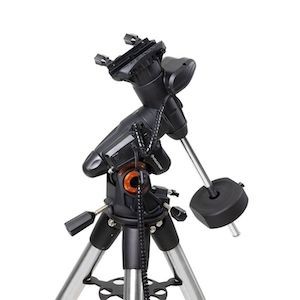
- High weight capacity
- Easy to use without plugging into a PC
- Dual Vixen/Losmandy saddle
Despite all the hatred it seems to receive, the Advanced VX is a workable – if not perfect – mount. It uses servo motors rather than steppers, and the declination axis has no bearings whatsoever – the result is that it has lots of backlash when slewing the mount around the sky and during autoguiding. However, there are plenty of fine images taken with Advanced VX mounts. If you can swing the extra $250 to buy the Sky-Watcher HEQ5 Pro, I would definitely recommend doing so, but there is absolutely no shame in owning or using a VX.
I would not recommend loading anything over about 14 pounds for imaging on the Advanced VX. But for visual use, you can max out its 30-pound capacity with no issues — something to consider if you plan on using the mount with another telescope.
3. Sky-Watcher HEQ5 Pro – Choice Under $1500
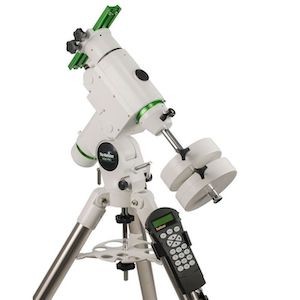
- Accurate tracking and guiding
- Lightweight and compact
- Fairly easy to set up
The Orion Sirius is functionally identical to the HEQ5 Pro—the only difference is that Sky-Watcher has better customer support and there seem to be more users of the HEQ5 Pro version than the Sirius out there.
The HEQ5 Pro has excellent tracking and guiding accuracy – it often guides in under an arc second – and is still quite lightweight and portable. The HEQ5’s 1.75” tripod legs are lighter than the Advanced VX, so it does theoretically suffer some minor payload capacity loss, but this is made up for by its increased tracking accuracy and other features. The HEQ5 is compatible with EQMod drivers and a variety of hardware accessories to allow you to get the most out of it and have plenty of room to grow, and there are some who have made the belt and tuning modifications to further improve tracking and guiding accuracy with this mount.
I would recommend putting a scope no heavier than 15 pounds or longer than 1200mm in focal length on the SkyWatcher HEQ5. It struggles with my 6” f/9 Ritchey-Chretien, for instance, which is right around those limits.
4. Sky-Watcher EQ6R Pro – Choice around $2000
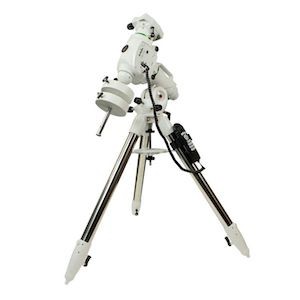
- Huge weight capacity
- Accurate tracking and guiding
- Fairly easy to set up
The original EQ6 mount was more or less a scaled-up copy of the HEQ5. With the EQ6R Pro, however, Sky-Watcher has added a belt drive upgrade (previously only available as a warranty-voiding mod for skilled DIYers), improved polar alignment features, and ergonomic enhancements. The EQ6R’s payload capacity is no slouch, either. For visual astronomy, you could load up to 44 pounds, while for astrophotography, you should be able to fit between 20-25 pounds before vibration and other issues start to occur.
Downsides? Weight. The mount head alone weighs 38 pounds, with the tripod coming in at another 16.5 pounds. Maneuvering the mount head onto the tripod is difficult, to say the least, and then there are the counterweights and your scope itself.
While the SkyWatcher EQ6R is certainly portable, it would be nice to store it on a dolly or in a permanent enclosure/observatory if possible.
5. iOptron CEM26EC – Choice above $2000
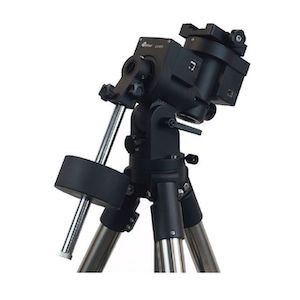
- Built in polar alignment camera makes setup a breeze
- Center balanced design means more weight capacity despite being a lightweight itself
- Built in WiFi
The iOptron CEM26EC isn’t the heaviest duty mount out there, but it has a built-in digital polar scope that you’d otherwise have to pay hundreds of dollars for to stick on as an aftermarket unit (such as the QHY PoleMaster). It also has built-in WiFi. As such, while capability-wise it’s quite similar to the Sky-Watcher HEQ5, the convenience factor is much higher. Additionally, its center balanced design makes it rather lightweight given its payload capacity of 26 lbs.


Hi,
I wonder if I can ask your thoughts on the sky-watcher AZ-GTi with updates software as an EQ Mount for astrophotography. Coupled with the Sky Watcher 72 ProEd you mentioned above.
Thanks for your time
Not enough capacity for that scope, it’s marginally better than a Star Adventurer
I have a Skyview Pro and was looking to buy the Truetrack dual axis motors for it so I can start doing astrophotography with my ED80T CF. Do you think this will be adequate or should I save up for a HEQ-5? I will also have to buy the polar alignment scope for the SVP if I decide to get the motors.
The TrueTrack is kind of a pain for astrophotography as it doesn’t have guiding capability nor GoTo. The SVP is heavy duty enough for the ED80T but has the aforementioned issues and doesn’t give you room to grow, I’d get the HEQ5.
I’ve been looking around online at different brands that sell GoTo mounts at around the same price point as the HEQ5 and have seen a few iOptron mounts that look nice (visually have no idea how they preform) but they all look the same but seem to be different variations of each other. Do you know if iOptron mounts are good and do you have any recommendation for versions?
Honestly I’m not that knowledgeable on the iOptron mounts, I would ask on /r/telescopes but I know some of them are pretty nice.
hello so they are selling me a 600 dll skywatcher eqm 35pro.but i have a celestron nexstar8se and im not sure if its ok can anyone let me know before i buy it.. ty in advance. or what would be the best yet cheapest eqm
Hi Telescopic Watch!
The offer of equipment for astronomy in my country is very limited, almost non-existent, I have been looking for automated equatorial mounts for a while and finally found the Explore Scientific iexos-100 pcm, I would like to know your opinion, I plan to use it with a Zhumel Z130
That should work reasonably well.